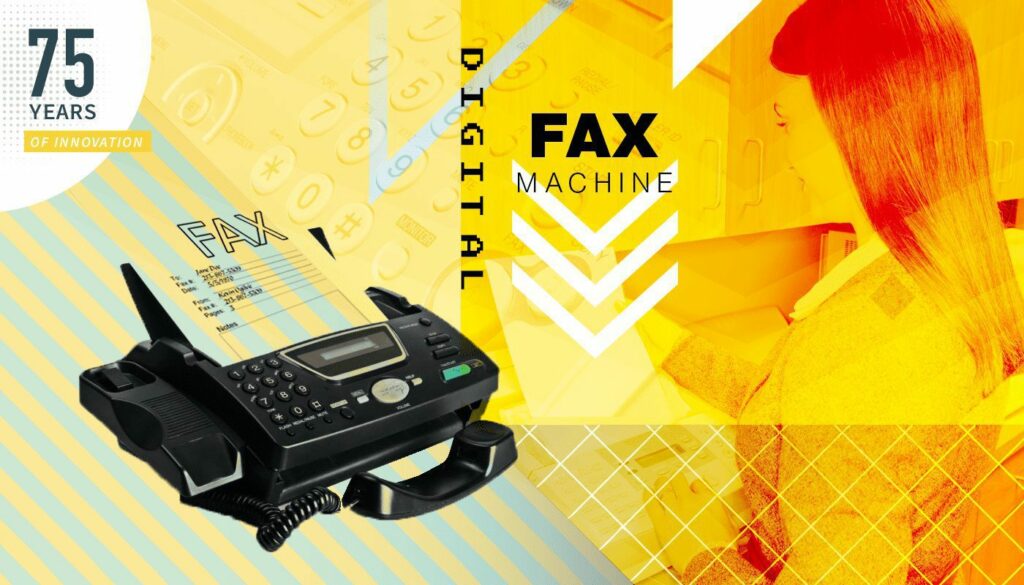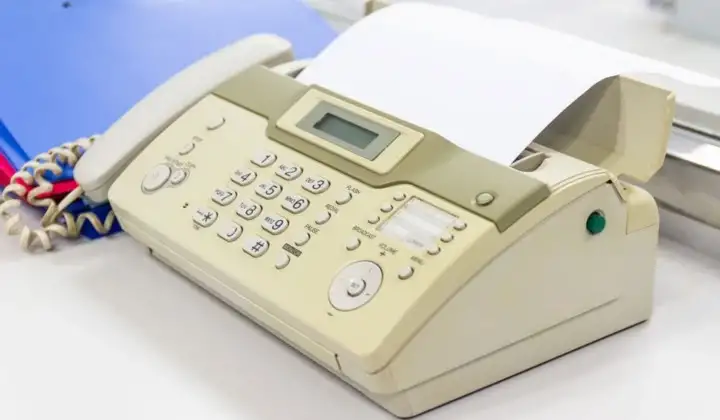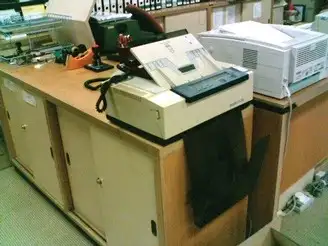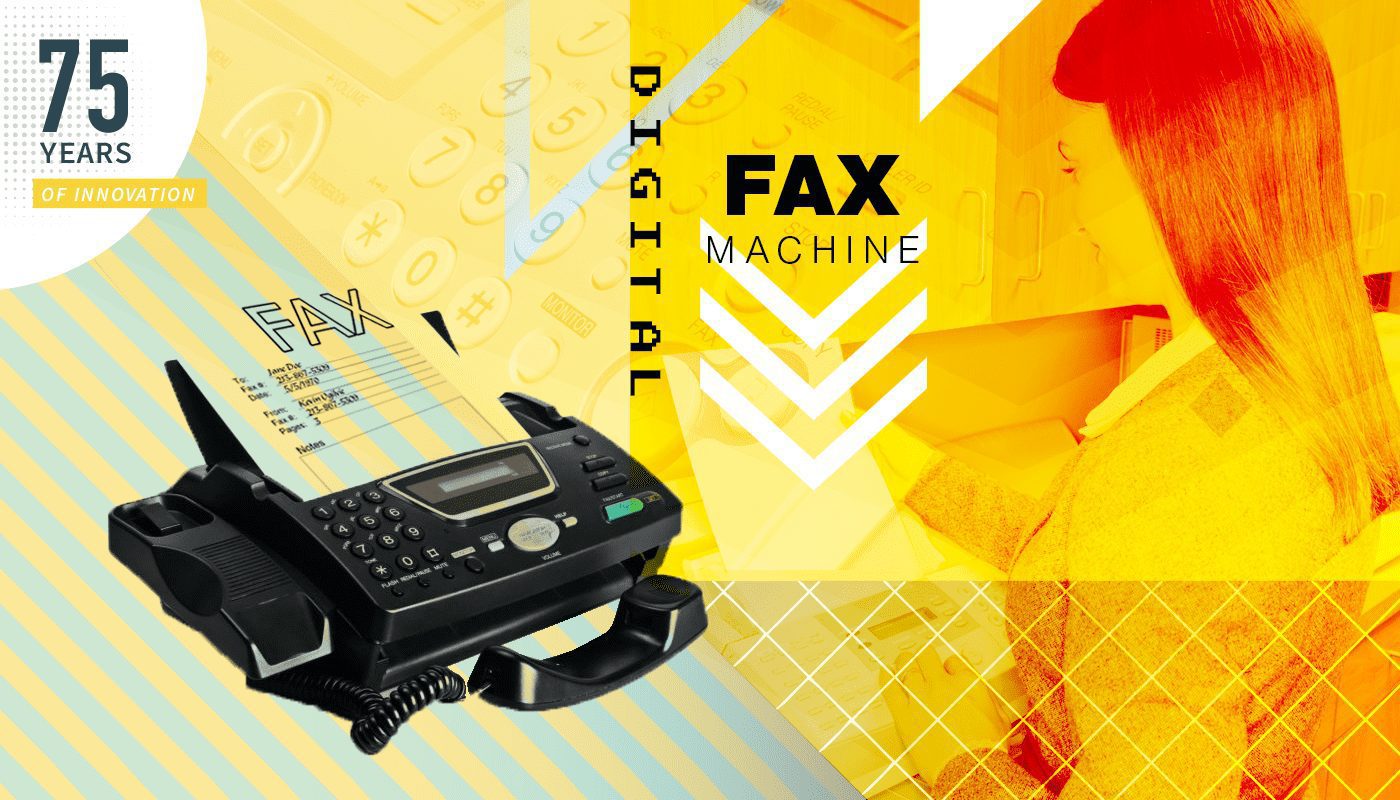The 75 Years of Innovation series highlights the groundbreaking innovations spanning from SRI’s founding in 1946 to today. Each week, SRI will release an innovation, leading up to its 75th anniversary in November 2021.

Commercialization of the fax machine to make sending a document fast, accurate, and available to all
The sound of data: delivering the digital fax machine…
Likely, if you are of a certain age, you will remember the distinctive sound of a fax coming through. That screechhhh….whirrrr….screech…sound is almost iconic. Not too long ago, the fax machine was a central part of any office environment. Before email, the fax was the fastest way to get documents and written communications from company to company. A fax machine may seem somewhat outdated now, but because this communication mechanism can be isolated from the internet, it still has value today. In some situations, including medical and insurance, a fax is often still seen as carrying more legal weight than an email. The fax machine persists, and its journey has been a long one.
In 1970, SRI International was contracted to commercialize the previous generation of slow and cumbersome fax machines. This is the story of delivering the digital fax machine.
Out of the light and dark came a strange sound…
The concept of ‘faxing data’ is surprisingly old. In 1843, Alexander Bain patented the “Electric Printing Telegraph” which was an early form of the modern-day fax machine. ‘Fax’ is short for facsimile (copy). Sending a fax works by scanning a document at one end, sending that data by telephony, and reproducing it on another fax machine. A fax machine has both the ability to scan and send, and to receive and reproduce. The faxing process begins with an optical scanner that differentiates between black and white. When a document is scanned in preparation for faxing, a light is used to reflect either dark or light; this represents the text and/or images in the document. The fax converts the dark/light to an electrical signal, which, in turn, is converted to sound for transmission across the telephone network; hence the strange screeecchh, whiirrrr, screech, tones heard when a fax is received.
At the receiving end, the reverse happens. The tones are converted back to an electrical signal, used to generate the facsimile image and convert the printout.

In versions of the analog fax machine, into to the late 1960s, while this method worked, it had several fundamental issues. Analog fax machines were very large and the preparation and sending process was slow and subject to interference, fax output was prone to error.
In 1970, SRI International was commissioned by Savin, CBS Television Services and Dacom to resolve the issues of the analog fax machine and create a commercial fax machine for widespread use.
SRI determined that a digital version of a fax machine, where tones correspond to binary 0 and 1, would resolve the inherent issues of sending a fax over phone lines. By digitizing the fax process, automation and error correction could be applied. The digital fax would allow computers to pre-prepare and queue facsimiles, which could be sent, en masse. The digital process would also allow for error correction, ensuring that any fax received was accurate. Speed was another important improvement offered by using a digital fax machine.
The lightning speed of the digital fax machine creates commercial roots
Using an optical scanner and modem sources, alongside SRI’s printer and signal processing skills, the development of the digital fax machine became a reality. The resulting prototype was named the Z-60 digital facsimile machine. This first version was bulky but fast. The Z-60 could scan, compress and transmit data at 4,800 bits per second, magnitudes faster than existing fax machines. In 1973, Ricoh acquired the rights to the technology developed by SRI. Ricoh released the RIFAX 600s, the world’s first commercially available digital fax machine. The RIFAX 600s, designed for general office use, could transmit an A4 page in 60 seconds compared to the several minutes needed by the contemporary fax machines of the 1970s.

In April 1973, the RIFAX 600s was used to demonstrate a fax transmission between Tokyo and New York via satellite communication. This demonstration placed the RIFAX 600s, based on SRI’s digital fax technology, as a globally leading technology brand.
In 1974, the RIFAX 600s was rebranded and released in Japan and the USA as the Rapifax 100. This innovation in fax technology allowed the fax to be used in a wide set of commercial situations resulting in the fax machine’s common use in companies across the globe. Subsequently, the numbers of fax machines in use, grew rapidly. In the USA, by 1970, there were only around 25,000 fax machines in use. By 1980, the numbers had grown to 250,000 fax machines. As 1990 approached, there were 5 million fax machines throughout the USA. The noise of a fax coming through permeate offices the world over to become an iconic sound of the twentieth century.
Resources
Center of the History of Japanese Industrial Technology http://sts.kahaku.go.jp/english/material/index.html
Ricoh, April 1973: https://www.ricoh.com/-/Media/Ricoh/Sites/com/about/company/history/pdf/1970_1984/197304.pdf
Engineering and Technology History Wiki: https://ethw.org/Fax_Machines



